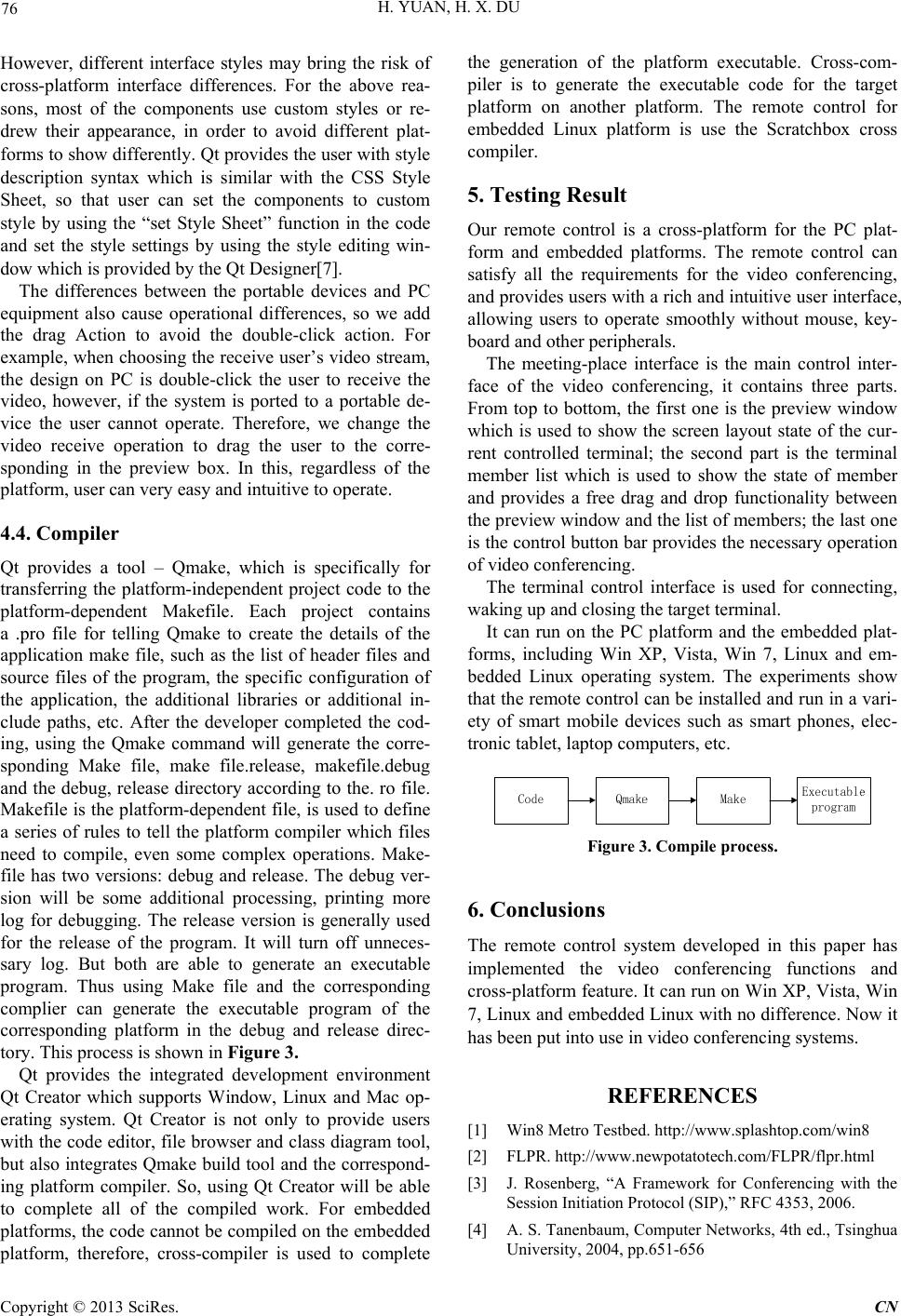
H. YUAN, H. X. DU
76
However, different interface styles may bring the risk of
cross-platform interface differences. For the above rea-
sons, most of the components use custom styles or re-
drew their appearance, in order to avoid different plat-
forms to show differently. Qt provides the user with style
description syntax which is similar with the CSS Style
Sheet, so that user can set the components to custom
style by using the “set Style Sheet” function in the code
and set the style settings by using the style editing win-
dow which is provided by th e Qt Designer[7].
The differences between the portable devices and PC
equipment also cause operational differences, so we add
the drag Action to avoid the double-click action. For
example, when choosing the receive user’s video stream,
the design on PC is double-click the user to receive the
video, however, if the system is ported to a portable de-
vice the user cannot operate. Therefore, we change the
video receive operation to drag the user to the corre-
sponding in the preview box. In this, regardless of the
platform, user can very easy and intuitive to operate.
4.4. Compiler
Qt provides a tool – Qmake, which is specifically for
transferring the platform-independent project code to the
platform-dependent Makefile. Each project contains
a .pro file for telling Qmake to create the details of the
application make file, such as the list of header files and
source files of the program, the specific configuration of
the application, the additional libraries or additional in-
clude paths, etc. After the developer completed the cod-
ing, using the Qmake command will generate the corre-
sponding Make file, make file.release, makefile.debug
and the debug, release directory according to the. ro file.
Makefile is the platform-dependent file, is used to define
a series of rules to tell the platform compiler which files
need to compile, even some complex operations. Make-
file has two versions: debug and release. The debug ver-
sion will be some additional processing, printing more
log for debugging. The release version is generally used
for the release of the program. It will turn off unneces-
sary log. But both are able to generate an executable
program. Thus using Make file and the corresponding
complier can generate the executable program of the
corresponding platform in the debug and release direc-
tory. This process is shown in Figure 3.
Qt provides the integrated development environment
Qt Creator which supports Window, Linux and Mac op-
erating system. Qt Creator is not only to provide users
with the code edito r, file browser and class diagram tool,
but also integrates Qmake build tool and the correspond-
ing platform compiler. So, using Qt Creator will be able
to complete all of the compiled work. For embedded
platforms, the code cannot be compiled on the embedded
platform, therefore, cross-compiler is used to complete
the generation of the platform executable. Cross-com-
piler is to generate the executable code for the target
platform on another platform. The remote control for
embedded Linux platform is use the Scratchbox cross
compiler.
5. Testing Result
Our remote control is a cross-platform for the PC plat-
form and embedded platforms. The remote control can
satisfy all the requirements for the video conferencing,
and provides users with a rich and intuitive user interface,
allowing users to operate smoothly without mouse, key-
board and other peripherals.
The meeting-place interface is the main control inter-
face of the video conferencing, it contains three parts.
From top to bottom, the first one is the preview window
which is used to show the screen layout state of the cur-
rent controlled terminal; the second part is the terminal
member list which is used to show the state of member
and provides a free drag and drop functionality between
the preview window and the list of members; the last one
is the control button bar provides the necessary operation
of video conferencing.
The terminal control interface is used for connecting,
waking up and closing the target terminal.
It can run on the PC platform and the embedded plat-
forms, including Win XP, Vista, Win 7, Linux and em-
bedded Linux operating system. The experiments show
that the remote control can be installed and run in a vari-
ety of smart mobile devices such as smart phones, elec-
tronic tablet, laptop computers, etc.
Figure 3. Compile process.
6. Conclusions
The remote control system developed in this paper has
implemented the video conferencing functions and
cross-platform feature. It can run on Win XP, Vista, Win
7, Linux and embedded Linux with no difference. Now it
has been put into use in video conferencing systems.
REFERENCES
[1] Win8 Metro Testbed. http://www.splashtop.com/win8
[2] FLPR. http://www.newpotatotech.com/FLPR/flpr.html
[3] J. Rosenberg, “A Framework for Conferencing with the
Session Initiation Protocol (SIP),” RFC 4353, 2006.
[4] A. S. Tanenbaum, Computer Networks, 4th ed., Tsinghua
University, 2004, pp.651-656
Copyright © 2013 SciRes. CN